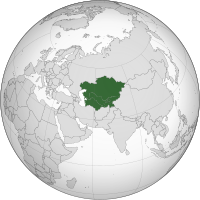Former Soviet Republics of Central Asia
| Central Asia | |
|---|---|
 |
|
| Area | 4,003,451 km2 (1,545,741 sq mi) |
|
|
| Countries | |
| Nominal GDP | $295.331 billion (2012) |
| GDP per capita | $6,044 (2012) |
Central Asia stretches from the Caspian Sea in the west to China in the east and from Afghanistan in the south to Russia in the north. It is also colloquially referred to as "the -stans" as the countries generally considered to be within the region all have names ending with the Persian suffix "-stan", meaning "land of".
Central Asia's five former Soviet republics are Kazakhstan (pop. 18 million), Kyrgyzstan (5.7 million), Tajikistan (8.0 million), Turkmenistan (5.2 million), and Uzbekistan (30 million), giving the region a total population of about 66 million. Although not a former Soviet republic, Afghanistan (pop. 29 million) is also sometimes included.
Central Asia has historically been closely tied to its nomadic peoples and the Silk Road. It has acted as a crossroads for the movement of people, goods, and ideas between Europe, Western Asia, South Asia, and East Asia. The Silk Road connected Muslim lands with the people of Europe, India, and China. This crossroads position has intensified the conflict between tribalism and traditionalism and modernization.
In pre-Islamic and early Islamic times, Central Asia was predominantly Iranian, populated by Eastern Iranian-speaking Bactrians, Sogdians, Chorasmians and the semi-nomadic Scythians and Parthians. After expansion by Turkic peoples, Central Asia also became the homeland for the Kazakhs, Uzbeks, Turkmen, Kyrgyz and Uyghurs and Turkic languages largely replaced the Iranian languages spoken in the area. Central Asia is sometimes referred to as Turkestan.
...
Wikipedia
